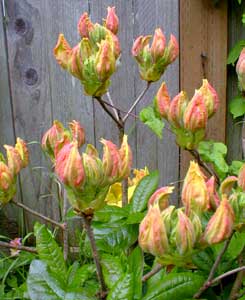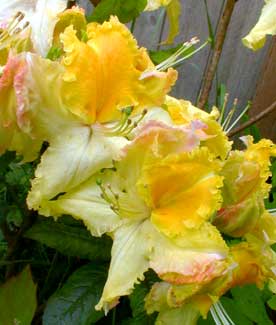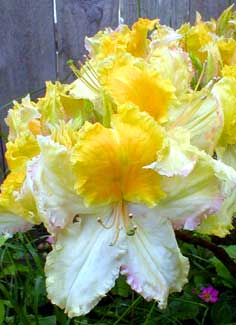
Azalea
'Washington State
Centennial'
"His rounds from bloom to bloom the bee begins
With flying song, & cowslip wine he sups,
Where to the warm & passing southern winds,
Azaleas gently swing their yellow cups."
-George Marion McClellan
(1860-1934)
(1860-1934)
'Centennial' is a deciduous azalea developed by Dr. Frank Mossman, a legendary rhododendron breeder in the Pacific Northwest.
It was selected by the Washington State Centennial Commission as the plant that was to honor one hundred years of statehood, & Briggs Nursery in Olympia was commissioned to develop 50,000 of the shrubs in time for the 1989 centennial year.
The cultivar's full name is 'Washington State Centennial,' but is frequently shortened to 'Centennial' & 'Washington Centennial.' Mossman bred the variety by starting with a crossed R. occidentale x cumberlandense, & pollinating that with the named rarity 'Santiam.'
 This latter hybrid ('Santiam') was from Howard Slonecker (d. 1998) of Milwaukee, Oregon, who named all his deciduous azaleas after Northwest Indian tribes & Oregon rivers. Like Frank Mossman, he had a particular interest in breeding the Northwest native azalea R. occidentale which to achieve 'Santiam' he crossed with Knap Hill azaleas in the quest for greater yellows.
This latter hybrid ('Santiam') was from Howard Slonecker (d. 1998) of Milwaukee, Oregon, who named all his deciduous azaleas after Northwest Indian tribes & Oregon rivers. Like Frank Mossman, he had a particular interest in breeding the Northwest native azalea R. occidentale which to achieve 'Santiam' he crossed with Knap Hill azaleas in the quest for greater yellows.Frank Mossman meanwhile had discovered that select clones of R. occidentale have an orange or yellow color on the upper two or three petals, occasionally on all the petals, & when these were crossed with one another, the upper petal variation was strongly preserved.
It was one of these clone sports he crossed with R. cumberlandense (formerly R. bakeri), an orange azalea native only to Kentucky's Cumberland Plateau. When that resulting shrub was bred to Slonecker's yellow 'Santiam,' the shrub 'Centennial' was born, which Mossman judged to possess a novel as well as beautiful flower.
The flowers are extremely varied, passing through various phases as they age. The buds start out orange-red in early May, opening to pink-edged pale orange-yellow with gilded golden-yellow dorsal. The pale pinks & yellows gradually soften to white, while the uppermost petal remains a vivid glowing yellow.
 Because of the changes its flowers go through, abbreviated descriptions can be contradictory, & photographs misleading, as some insist it is white with yellow top-petal, & other listings describe it as pink or as orange throughout. The ideal specimen will exhibit all these colors, beginning tricolored pink & pale yellow-orange & bright gold, fading to bicolor white with large dorsal blotch remaining gold.
Because of the changes its flowers go through, abbreviated descriptions can be contradictory, & photographs misleading, as some insist it is white with yellow top-petal, & other listings describe it as pink or as orange throughout. The ideal specimen will exhibit all these colors, beginning tricolored pink & pale yellow-orange & bright gold, fading to bicolor white with large dorsal blotch remaining gold.It is a very frilly blossom into the bargain, in large round trusses of up to a dozen of the ruffled trumpets which in fullest bloom can hide the leaves entirely.
Its chief parent R. occidentale is exceedingly redolent, & happily 'Washington State Centennial' preserves this wonderful redolence. It's scent can be detected from a considerable distance.
The large tough leaves are shiny, rumpled or quilted-looking, & mildew-resistant, making for a very pretty leafy bush even when not in bloom. It furthermore puts on a superb autumn display, when the leaves turn deep purple & shades of mahogany, remaining very shiny, as can be seen on the Centennial Azalea Autumn Leaves Page. After leaf-fall, the limb structure of a mature specimen is very pleasing for the winter garden.
For more about Mossman & his shrubs, see the page about Frank Mossman's & Britt Smith's Western & Flame Azalea Hybrid, a shrub we are delighted to have from Britt Smith's very own garden.
For more photographs of this shrub, go to the:
'Centennial' Azalea Page of the Rhododendron Gallery